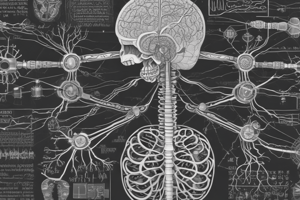Podcast
Questions and Answers
What happens to the axons of approximately 50 percent of neurons that do not find vacant postsynaptic cells?
What happens to the axons of approximately 50 percent of neurons that do not find vacant postsynaptic cells?
They die by apoptosis.
What signal does a presynaptic neuron receive from the postsynaptic cell when establishing synaptic connections?
What signal does a presynaptic neuron receive from the postsynaptic cell when establishing synaptic connections?
A signal that permits it to survive.
Why does the evolutionary process involve overproduction of neurons?
Why does the evolutionary process involve overproduction of neurons?
To let them fight to establish synaptic connections.
What role does symmetrical division play in increasing the size of the brain according to Rakic (1988, 2009)?
What role does symmetrical division play in increasing the size of the brain according to Rakic (1988, 2009)?
How many additional symmetrical divisions would account for the difference between human and rhesus macaque brains?
How many additional symmetrical divisions would account for the difference between human and rhesus macaque brains?
Why does symmetrical division last two days longer in humans compared to other species?
Why does symmetrical division last two days longer in humans compared to other species?
What is the neuraxis and how is it defined in relation to the central nervous system?
What is the neuraxis and how is it defined in relation to the central nervous system?
What is the difference between anterior and posterior in relation to the central nervous system?
What is the difference between anterior and posterior in relation to the central nervous system?
Explain the difference between dorsal and ventral in relation to the central nervous system.
Explain the difference between dorsal and ventral in relation to the central nervous system.
What is the difference between ipsilateral and contralateral in relation to the central nervous system?
What is the difference between ipsilateral and contralateral in relation to the central nervous system?
Describe the different types of brain slices or planes used to view the central nervous system.
Describe the different types of brain slices or planes used to view the central nervous system.
What is the function of the motor cortex in the central nervous system?
What is the function of the motor cortex in the central nervous system?
What is the primary function of the meninges?
What is the primary function of the meninges?
What is the subarachnoid space, and what does it contain?
What is the subarachnoid space, and what does it contain?
What is the significance of the brain receiving 20% of the blood flow from the heart?
What is the significance of the brain receiving 20% of the blood flow from the heart?
How does the cerebrospinal fluid (CSF) contribute to protecting the brain?
How does the cerebrospinal fluid (CSF) contribute to protecting the brain?
What is the function of the blood-brain barrier?
What is the function of the blood-brain barrier?
Why is the brain considered the most protected organ in the body?
Why is the brain considered the most protected organ in the body?
What is the primary difference between CAT scans and MRI scans?
What is the primary difference between CAT scans and MRI scans?
Explain briefly how an MRI scan works.
Explain briefly how an MRI scan works.
What advantage does an MRI have over a CAT scan?
What advantage does an MRI have over a CAT scan?
What does the example CAT scan series illustrate?
What does the example CAT scan series illustrate?
Why is iodine-containing contrast material sometimes used in CAT scans?
Why is iodine-containing contrast material sometimes used in CAT scans?
What is a key advantage of MRI in imaging the brain compared to other techniques?
What is a key advantage of MRI in imaging the brain compared to other techniques?
What are the two main goals of research in studying the brain according to the passage?
What are the two main goals of research in studying the brain according to the passage?
What is the function of the motor cortex described in the passage?
What is the function of the motor cortex described in the passage?
What is the process of generalization that the passage describes?
What is the process of generalization that the passage describes?
What is the second goal of research in studying the brain described in the passage?
What is the second goal of research in studying the brain described in the passage?
What are the three behavioral difficulties described in the patient case?
What are the three behavioral difficulties described in the patient case?
What is the physiological explanation for the patient's complex set of symptoms?
What is the physiological explanation for the patient's complex set of symptoms?




